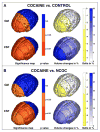Prenatal cocaine effects on brain structure in early infancy
- PMID: 24999039
- PMCID: PMC4224027
- DOI: 10.1016/j.neuroimage.2014.06.070
Prenatal cocaine effects on brain structure in early infancy
Abstract
Prenatal cocaine exposure (PCE) is related to subtle deficits in cognitive and behavioral function in infancy, childhood and adolescence. Very little is known about the effects of in utero PCE on early brain development that may contribute to these impairments. The purpose of this study was to examine brain structural differences in infants with and without PCE. We conducted MRI scans of newborns (mean age = 5 weeks) to determine cocaine's impact on early brain structural development. Subjects were three groups of infants: 33 with PCE co-morbid with other drugs, 46 drug-free controls and 40 with prenatal exposure to other drugs (nicotine, alcohol, marijuana, opiates, SSRIs) but without cocaine. Infants with PCE exhibited lesser total gray matter (GM) volume and greater total cerebral spinal fluid (CSF) volume compared with controls and infants with non-cocaine drug exposure. Analysis of regional volumes revealed that whole brain GM differences were driven primarily by lesser GM in prefrontal and frontal brain regions in infants with PCE, while more posterior regions (parietal, occipital) did not differ across groups. Greater CSF volumes in PCE infants were present in prefrontal, frontal and parietal but not occipital regions. Greatest differences (GM reduction, CSF enlargement) in PCE infants were observed in dorsal prefrontal cortex. Results suggest that PCE is associated with structural deficits in neonatal cortical gray matter, specifically in prefrontal and frontal regions involved in executive function and inhibitory control. Longitudinal study is required to determine whether these early differences persist and contribute to deficits in cognitive functions and enhanced risk for drug abuse seen at school age and in later life.
Keywords: CSF enlargement; Cortical gray matter; Infant brain development; Magnetic resonance imaging; Prenatal cocaine; Prenatal substance abuse.
Copyright © 2014 Elsevier Inc. All rights reserved.
Figures


Similar articles
-
Alcohol exposure in utero is associated with decreased gray matter volume in neonates.Metab Brain Dis. 2016 Feb;31(1):81-91. doi: 10.1007/s11011-015-9771-0. Epub 2015 Nov 29. Metab Brain Dis. 2016. PMID: 26616173 Free PMC article.
-
An examination of the association between prenatal cocaine exposure and brain activation measures of arousal and attention in young adults: An fMRI study using the Attention Network Task.Neurotoxicol Teratol. 2018 Sep-Oct;69:1-10. doi: 10.1016/j.ntt.2018.06.004. Epub 2018 Jun 25. Neurotoxicol Teratol. 2018. PMID: 29953942
-
Executive function and cortical thickness in youths prenatally exposed to cocaine, alcohol and tobacco.Dev Cogn Neurosci. 2015 Dec;16:155-165. doi: 10.1016/j.dcn.2015.01.010. Epub 2015 Feb 2. Dev Cogn Neurosci. 2015. PMID: 25743199 Free PMC article.
-
Fetal alcohol and drug effects.Neurologist. 2003 Nov;9(6):267-79. doi: 10.1097/01.nrl.0000094941.96358.d1. Neurologist. 2003. PMID: 14629781 Review.
-
A review of the effects of prenatal cocaine exposure among school-aged children.Pediatrics. 2010 Mar;125(3):554-65. doi: 10.1542/peds.2009-0637. Epub 2010 Feb 8. Pediatrics. 2010. PMID: 20142293 Free PMC article. Review.
Cited by
-
Thalamocortical functional connectivity and behavioral disruptions in neonates with prenatal cocaine exposure.Neurotoxicol Teratol. 2016 Jul-Aug;56:16-25. doi: 10.1016/j.ntt.2016.05.009. Epub 2016 May 27. Neurotoxicol Teratol. 2016. PMID: 27242332 Free PMC article.
-
Prenatal drug exposure and executive function in early adolescence.Neurotoxicol Teratol. 2021 Nov-Dec;88:107036. doi: 10.1016/j.ntt.2021.107036. Epub 2021 Oct 11. Neurotoxicol Teratol. 2021. PMID: 34648914 Free PMC article.
-
Placental genomic risk scores and early neurodevelopmental outcomes.Proc Natl Acad Sci U S A. 2021 Feb 16;118(7):e2019789118. doi: 10.1073/pnas.2019789118. Proc Natl Acad Sci U S A. 2021. PMID: 33558239 Free PMC article.
-
Prenatal exposures and infant brain: Review of magnetic resonance imaging studies and a population description analysis.Hum Brain Mapp. 2019 Apr 15;40(6):1987-2000. doi: 10.1002/hbm.24480. Epub 2018 Nov 19. Hum Brain Mapp. 2019. PMID: 30451332 Free PMC article. Review.
-
Prenatal drug exposure affects neonatal brain functional connectivity.J Neurosci. 2015 Apr 8;35(14):5860-9. doi: 10.1523/JNEUROSCI.4333-14.2015. J Neurosci. 2015. PMID: 25855194 Free PMC article.
References
-
- Avants BB, Hurt H, et al. Effects of heavy in utero cocaine exposure on adolescent caudate morphology. Pediatr Neurol. 2007;37(4):275–279. - PubMed
-
- Bandstra ES, Morrow CE, et al. Longitudinal investigation of task persistence and sustained attention in children with prenatal cocaine exposure. Neurotoxicol Teratol. 2001;23(6):545–559. - PubMed
Publication types
MeSH terms
Substances
Grants and funding
- M01 RR000046/RR/NCRR NIH HHS/United States
- 1P01DA022446-01A1/DA/NIDA NIH HHS/United States
- U54EB005149/EB/NIBIB NIH HHS/United States
- P50 MH064065/MH/NIMH NIH HHS/United States
- R01MH070890/MH/NIMH NIH HHS/United States
- U54 HD079124/HD/NICHD NIH HHS/United States
- R01 MH070890/MH/NIMH NIH HHS/United States
- K01 DA019949/DA/NIDA NIH HHS/United States
- P01 DA022446/DA/NIDA NIH HHS/United States
- U54 EB005149/EB/NIBIB NIH HHS/United States
- K01DA019949-01A1/DA/NIDA NIH HHS/United States
- MH064065/MH/NIMH NIH HHS/United States
LinkOut - more resources
Full Text Sources
Other Literature Sources

